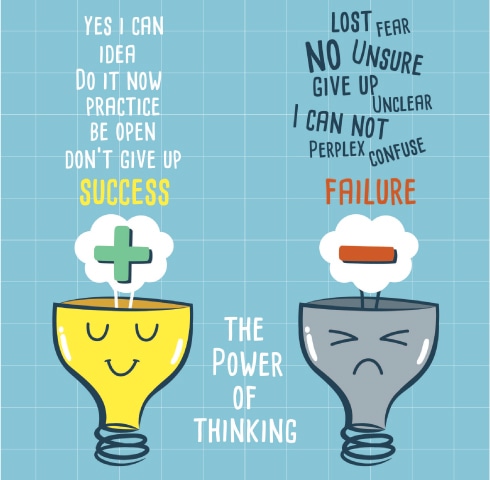How to Use Negative Thoughts to Achieve Your Goals

A thought, like a small black bubble, enters your mind: "I'm not good enough." Or "This will never work out." These bubbles start small but can grow, filling your mind. They can drain your enthusiasm and hinder your progress toward your goals. Many of us are familiar with these inner voices. You might think the only solution is to fight or ignore them. But what if I told you these thoughts could actually guide you? This article shows you how to use negative thoughts as fuel for progress and unleash your inner strength instead of fighting them in vain.
Table of Contents:
- Section 1: Negative Thoughts, Enemy or Guide?
- Section 2: The Mind’s Toolbox: Practical Techniques for Managing Negative Thoughts
- Section 3: Turn Negative Thoughts into Driving Energy
- Section 4: Build New Habits for a Resilient Mind
- Conclusion: From Darkness to Light, an Inner Journey
Section 1: Negative Thoughts, Enemy or Guide?
Negative thoughts are a natural part of the human survival mechanism. Our minds constantly predict negative scenarios to protect us from dangers. But sometimes, this protective system becomes overactive, issuing warnings that no longer serve us. Ignoring these thoughts doesn’t end them; it makes them stronger. They’re like a child crying louder for attention.
Where Do Negative Thoughts Come From, and What Message Do They Carry?
Negative thoughts often stem from past experiences. Painful memories, failures, or criticism from others can turn into destructive thought patterns. However, every negative thought carries a hidden message. Fear of failure might indicate that the task is deeply important to you, urging you to act with greater care. Comparing yourself to others can spark motivation to grow and improve your skills. The core message of these thoughts is: "There’s a problem, and you need to address it."
Why Suppressing Negative Thoughts Backfires
Our brains are wired to amplify whatever we focus on. The more you try not to think about something, the more you think about it. This is known as the "white bear effect." Suppressing negative thoughts pushes them into the subconscious, where they influence our decisions and emotions. Instead of suppression, it’s better to acknowledge them and use them as a source of insight.
Identifying Destructive vs. Constructive Thoughts
Destructive thoughts, like "I can’t do anything right" or "I’m a failure," drag us down without solid reasoning. Constructive thoughts, however, help us solve problems. Instead of saying, "I’ll never finish this project," you could say, "This project is big; I should break it into smaller, manageable parts." Recognizing the difference between these two types of thoughts is the first step toward change.
Section 2: The Mind’s Toolbox: Practical Techniques for Managing Negative Thoughts
Controlling negative thoughts, like any skill, requires practice. This section provides tools to help you take charge of your mind.
Mindfulness: Be an Impartial Observer of Your Thoughts
Mindfulness means living in the moment and observing your thoughts, feelings, and senses without judgment. When a negative thought arises, instead of reacting immediately, observe it. Let it pass like a cloud in the sky of your mind. This helps you detach and realize you are not your thoughts—you just have them.
Identify and Replace: Counter a Negative Thought with a Positive One
When a negative thought strikes, identify it and replace it with a realistic, positive one. For example, if you think, "I’ll fail this job interview," shift it to, "I’ve prepared for this interview and will do my best." This technique builds new neural pathways in your brain, gradually strengthening positive thoughts.
The 5-Second Rule: Don’t Let Negative Thoughts Stop You
Sometimes, negative thoughts prevent us from doing what we know we should. For instance, you want to go to the gym, but a thought says, "You’re too tired." In that moment, use the 5-second rule: count down from 5 to 1 and act within those first 5 seconds. This allows you to move before your brain stops you.
The Role of Gratitude in Shifting Thought Patterns
Your mind can’t focus on gratitude and negative thoughts at the same time. Take a few minutes each day to be grateful for what you have—a roof over your head, a good friend, or even a warm cup of coffee in the morning. Gratitude strengthens positive neural pathways and shifts your perspective on life.

Section 3: Turn Negative Thoughts into Driving Energy
Now that you’ve learned to manage negative thoughts, it’s time to use them as a source of energy.
Fear of Failure: A Roadmap to Success
Fear of failure is one of the most powerful negative thoughts. But it’s a valuable warning: "This matters to you, so take it seriously." Use this fear to plan more carefully, practice more, and prepare thoroughly. Fear of failure can push you toward success, not stop you.
Worry About the Future: Plan and Prepare for Big Steps
Worry about the future can feel like a barrier. But if guided correctly, it can become a strong motivator for planning. Instead of drowning in "What if?" thoughts, use that energy to create an actionable plan. For example, if you’re worried about your career, learn a new skill, update your resume, or connect with professionals in your field.
Envy and Comparison: Draw Inspiration from Others’ Success
Envy can create negative feelings. But instead of letting it hurt you, use it as a sign. Envy shows what you value and want to achieve. Take inspiration from others’ success. Ask yourself, "How did they get there?" Then learn from them and find your own path.
The Inner Critic: A Guide for Improvement and Growth
Your inner critic always points out flaws. Instead of fighting it, use it as a guide. Listen to it, but don’t believe it blindly. Use it to identify weaknesses and plan for improvement. This voice can help you become more precise and enhance your performance.
Section 4: Build New Habits for a Resilient Mind
Lasting change in how you think requires a change in lifestyle.
The Importance of Exercise and Nutrition for Mental Health
Your body and mind are connected. Regular exercise reduces stress and boosts happiness hormones. Proper nutrition directly impacts brain function and emotional regulation. Caring for your body helps your mind work better.
The Power of Sleep and Its Impact on Mental Performance
Lack of sleep severely limits your ability to manage stress and negative thoughts. Sufficient sleep allows your brain to process information and regulate emotions. A consistent sleep schedule equips you with a strong mind to face daily challenges.
Find a Friend or Mentor: Seek Social Support
Believing you must face negative thoughts alone is a mistake. Talking to a trusted friend, mentor, or therapist can offer new perspectives. Sharing your thoughts and concerns reduces mental strain and helps you find solutions.
How a Success Journal Invites Positivity into Your Life
Keep a journal and write down three small successes each day. These could be big achievements, like completing a project, or small ones, like waking up on time. This practice helps you focus on your progress and see your strengths instead of dwelling on negative thoughts.
Conclusion: From Darkness to Light, an Inner Journey
Negative thoughts are just shadows born from the darkness of your mind, but with awareness, tools, and determination, you can turn them into light to illuminate your path to progress. Remember, every negative thought hides an opportunity, and you have the power to uncover it.
This article is just a guide. Now it’s your turn to act. Decide today to challenge a negative thought, flip it around, and see what lesson or opportunity it holds. Taking action is the first step in a profound inner journey. Are you ready?